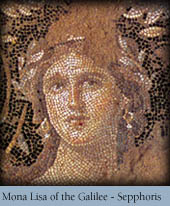
These discoveries began to emerge twenty-five years ago, when a team of archaeologists, including Eric and Carol Meyers, began to excavate a city located less than four miles from Nazareth, easily accessible in an hours walk. The city is Sepphoris. It was destroyed in a political feud in about 4 BCE -- the approximate date of the birth of Jesus -- and it was rebuilt during the time that Jesus was growing up nearby. Known as the "ornament of the Galilee", Sepphoris was wealthy, sophisticated and predominately Jewish. An elaborate system of water works kept residents supplied with fresh water; satellite villages such as Nazareth may have kept it supplied with food.
What impact did proximity to Sepphoris have on the life of Jesus? Scholars disagree. Tradition describes him as a carpenter or tekton. If so, then Jesus might have been employed in rebuilding the city. Meyers speculates such employment would have required Jesus to speak Greek, in addition to Hebrew and Aramaic. "Jesus was tri-lingual," he says. "You couldn't deal and wheel, either in the workplace or in the market without knowing a good deal of Greek. And I can hardly imagine anybody worth their salt who wouldn't know some Greek."
But some scholars, including Do Crossan, argue that Jesus' closest companions were fishermen and that the parables all reflect a rural environment. Others concede that Jesus may have visited or worked in nearby Seppphoris. But they question whether the city's veneer of Greek culture and sophistication would have affected anyone outside of its wealthy social elite.
The influence of Sepphoris on Jesus remains an intriguing mystery, one that can generate only hypotheses, not clear answers that satisfy yearning for historial certainty.